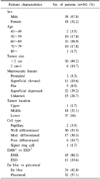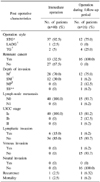Abstract
Purpose
Recently, early gastric cancer has increased in Korea. Thus, endoscopic resection and laparoscopic gastrectomy has increased in early gastric cancer patients. But, endoscopic resection of early gastric cancer has many problems such as poor long-term survival data, diverse endoscopic techniques, ambiguous follow-up strategy, nonuniform pathologic interpretation and so on. We studied patients that received additional gastrectomy after EMR/ESD. We analyzed clinicopathological characteristics states before and after EMR/ESD.
Methods
From 1998 to 2008, 56 patients received additional gastrectomy after EMR/ESD due to gastric cancer. We analyzed tumor characteristics, endoscopic resection type, reasons for gastrectomy, post-operative characteristics, etc., retrospectively from medical records.
Results
The ratio of male to female was 2:1. Six patient tumors were larger than 2 cm in size. Forty-five patients received EMR and 12 patients received ESD. Common macroscopic feature of endoscopic findings were superficial elevated and superficial depressed between 10 mm and 20 mm. Forty patients received immediate gastrectomy due to incomplete endoscopic resection. Sixteen patients received additional gastrectomy during follow-up period after EMR/ESD. The most common reason of immediate gastrectomy was positive resection margin. The most common reason of follow-up gastrectomy was cancer recurrence. Three patients had advanced gastric cancer in follow up gastrectomy group. Two patients died due to gastric cancer in immediate gastrectomy group and follow-up gastrectomy group.
Conclusion
Active effort for surgical treatment is needed when the gastric cancer characteristics of patients is inadequate for endoscopic resection. Uniform pathologic interpretation is essential for confirming completeness of endoscopic resection. Treatment and follow-up strategy after endoscopic resection is important due to recurrence and new cancer occurrence. Long-term and prospective randomized study should be performed to confirm safety and difficulty of endoscopic resection.
Figures and Tables
References
1. Tada M, Murata M, Takemoto T, Shimada M, Murakami F, Mizumachi S, et al. Development of strip-off biopsy. Gastroenterol Endosc. 1984. 26:833–839.
2. Tada M, Murakami A, Karita M, Yanai H, Okita K. Endoscopic resection of early gastric cancer. Endoscopy. 1993. 25:445–450.
3. Kim JJ, Kim BJ. Current status of endoscopic mucosal resection for early gastric cancer in Korea. Korean J Med. 2009. 76:291–295.
4. Jung HY. Extended Approach of EMR/ESD in Stomach Cancer: CON. J Korean Gastric Cancer Assoc. 2008. 8:5–8.
5. Kim HO, Choi WB, Shin JH, Yoo CH. An investigation of patients who have undergone curative gastrectomy after incomplete endoscopic mucosal resection with a diagnosis of early gastric cancer. J Korean Surg Soc. 2008. 74:187–191.
6. Goto O, Fujishiro M, Kakushima N, Kodashima S, Ono S, Yamaguchi H, et al. Endoscopic submucosal dissection as a staging measure may not lead to worse prognosis in early gastric cancer patients with additional gastrectomy. Dig Liver Dis. 2008. 40:293–297.
7. Etoh T, Ishikawa K, Shiromizu A, Yasuda K, Inomata M, Shiraishi N, et al. Clinicopathologic features and treatment of residual early cancers after endoscopic mucosal resection of the stomach. J Clin Gastroenterol. 2006. 40:801–805.
8. Chung YS, Park DJ, Lee HJ, Kim SG, Jung HC, Song IS, et al. The role of surgery after incomplete endoscopic mucosal resection for early gastric cancer. Surg Today. 2007. 37:114–117.
9. Jang BI. Follow-up of endoscopic mucosal resection for gastric adenoma and early gastric cancer. Korean J Med. 2006. 71:469–472.
10. Song KY, Hyung WJ, Kim HH, Han SU, Cho GS, Ryu SW, et al. Is gastrectomy mandatory for all residual or recurrent gastric cancer following endoscopic resection? A large-scale Korean multi-center study. J Surg Oncol. 2008. 98:6–10.
11. Ono H, Kondo H, Gotoda T, Shirao K, Yamaguchi H, Saito D, et al. Endoscopic mucosal resection for treatment of early gastric cancer. Gut. 2001. 48:225–229.
12. Oka S, Tanaka S, Kaneko I, Mouri R, Hirata M, Kawamura T, et al. Advantage of endoscopic submucosal dissection compared with EMR for early gastric cancer. Gastrointest Endosc. 2006. 64:877–883.
13. Isomoto H, Shikuwa S, Yamaguchi N, Fukuda E, Ikeda K, Nishiyama H, et al. Endoscopic submucosal dissection for early gastric cancer: a large-scale feasibility study. Gut. 2009. 58:331–336.
14. Ohnita K, Isomoto H, Yamaguchi N, Fukuda E, Nakamura T, Nishiyama H, et al. Factors related to the curability of early gastric cancer with endoscopic submucosal dissection. Surg Endosc. Epub 2009 Apr 9.
15. Oda I, Gotoda T, Sasako M, Sano T, Katai H, Fukagawa T, et al. Treatment strategy after non-curative endoscopic resection of early gastric cancer. Br J Surg. 2008. 95:1495–1500.
16. Yokoi C, Gotoda T, Hamanaka H, Oda I. Endoscopic submucosal dissection allows curative resection of locally recurrent early gastric cancer after prior endoscopic mucosal resection. Gastrointest Endosc. 2006. 64:212–218.
17. Oka S, Tanaka S, Kaneko I, Mouri R, Hirata M, Kanao H, et al. Endoscopic submucosal dissection for residual/local recurrence of early gastric cancer after endoscopic mucosal resection. Endoscopy. 2006. 38:996–1000.
18. Kitamura T, Tanabe S, Koizumi W, Mitomi H, Saigenji K. Argon plasma coagulation for early gastric cancer: technique and outcome. Gastrointest Endosc. 2006. 63:48–54.
19. Ginsberg GG. The art and science of painting in early gastric cancer: is there a role for ablation therapy. Gastrointest Endosc. 2006. 63:55–59.
20. Kojima T, Parra-Blanco A, Takahashi H, Fujita R. Outcome of endoscopic mucosal resection for early gastric cancer: review of the Japanese literature. Gastrointest Endosc. 1998. 48:550–554.
21. Manner H, Rabenstein T, May A, Pech O, Gossner L, Werk D, et al. Long-term results of endoscopic resection in early gastric cancer: the Western experience. Am J Gastroenterol. 2009. 104:566–573.
22. Kim JJ, Lee JH, Jung HY, Lee GH, Cho JY, Ryu CB, et al. EMR for early gastric cancer in Korea: a multicenter retrospective study. Gastrointest Endosc. 2007. 66:693–700.




 PDF
PDF ePub
ePub Citation
Citation Print
Print







 XML Download
XML Download